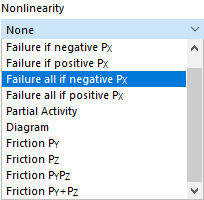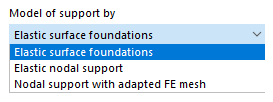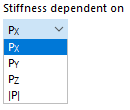Supports are used to transfer loads applied to a structural system into the foundations. Without supports, all nodes would be free and could be displaced or rotated freely. If you want a node to act as a support, at least one of its degrees of freedom must be restricted by a spring or blocked. In addition, the node must be part of a surface or a member.
Imposed deformations of a node are only possible for appropriately supported nodes.
If you want to assign nonlinear properties to a nodal support, you can define failure criteria for tensile or compressive forces, tearing and yielding, or stress-strain and stiffness diagrams.
The checkbox symbol of a user-defined nodal support indicates the restrained degrees of freedom. The following support types are predefined:
- Pinned
- Fixed
- Roller
- Roller in X'
- Roller in Y'
Main
The Main tab manages the basic support parameters.
Coordinate System
Each nodal support has a local coordinate system. By default, it is oriented parallel to the global axes X, Y, and Z. If you have created a user-defined coordinate system or defined one using the
![]() button, you can also use this reference system.
button, you can also use this reference system.
Support Conditions
The support conditions are divided into "Translational" and "Rotational" degrees of freedom. Translational degrees describe supports in the direction of the support axes; rotational degrees describe restraints about these axes.
To define a support or restraint, select the check box for the respective axis. The check mark indicates that the degree of freedom is blocked and the displacement or rotation of the node in or about the corresponding direction is impossible.
If no support or restraint is available, clear the respective check box. The constant of the translational or rotational spring is then set to zero. You can adjust the "Spring constant" anytime in order to model an elastic support of the node. Enter the spring stiffnesses as design values.
In the "Nonlinearity" column, you can specifically control the transfer of internal forces and moments for each component. Depending on the degree of freedom, suitable entries are available for selection in the list of nonlinearities.
Supports acting nonlinearly are displayed by a different color in the graphic.
Failure if support force/moment is negative or positive
This allows you to control easily whether the support can absorb only positive or negative forces or moments: If a force or a moment acts in the forbidden direction, that particular component of the support fails. The remaining restraints stay effective.
The "negative" or "positive" directions refer to the forces or moments that are applied to the nodal support with regard to the respective axes (they do not refer to the reaction forces on the part of the support). The signs result from the direction of the global axes: For example, if the global Z-axis is oriented downwards, the "Self-weight" load case results in a positive support force PZ.
Failure all if support force/moment is negative or positive
In contrast to the above-mentioned failure of a single component, the support fails completely once the component is ineffective.
When you select a different nonlinearity, you can define the parameters in the Partial Activity, Diagram, or Friction tabs.
Options
Use the check boxes in this dialog section to define further properties of the nodal support. Depending on the selection, the Specific Direction or Stiffness via Fictitious Column tabs are added. If the "Concrete Design" add-on is activated, an additional check box is available for defining the support dimensions.
Specific Direction
The Specific Direction tab allows you to rotate the support. This means you do not need to create a user-defined coordinate system.
Direction Type
There are several options for aligning the support: You can rotate the support about the support axes X', Y', and Z', direct it to one or two nodes, or arrange it parallel to a member or a line. You can select the objects graphically using the
![]() button.
button.
Stiffness via Fictitious Column
The Stiffness via Fictitious Column tab is particularly recommended for point supports of 2D structures. Here, you can determine the support spring constants from the parameters of a column that is not represented in the model. Furthermore, since a point support describes the conditions in the column head area only rudimentarily, special column macro elements are available. RFEM determines the spring constants of the support from the boundary conditions. This allows for realistic modeling without singularity effects that would result for a fixed support in a single FE node.
Parameters
As a "Model of support", three approaches are available for selection. They are symbolized in the dialog graphic.
- With the "Elastic surface foundations" model, a surface that is elastically supported is detached within the column dimensions. The foundation coefficients are calculated from the column's geometry and material data.
- With the "Elastic nodal support" model, a surface is detached and supported in a point-like manner. The support is provided with translational and rotational springs, which result from the geometry and material data of the column. To account for higher bending stiffness in the column area, the surface is doubled internally.
- The "Nodal support with adapted FE mesh" model corresponds to the elastic nodal support, but no springs are applied to the point-like supports.
Enter the data for the column that are required to determine the spring stiffnesses. The "Column head" geometry can be described as rectangular or circular, optionally by a rotation of the column.
The "Column height" affects the constants of the translational and rotational springs.
Column Section and Material
The cross-section and material properties of the column are required to determine the spring stiffnesses. If the column is not the "Same as column head" (neither rectangular nor circular), you can select the appropriate column cross-section in the list or define a new one.
Select the "Column material" from the list. You can create a new material using the
![]() and
and
![]() buttons.
buttons.
Column Conditions
The support type at the column head and at the column base is included in the determination of the translational and rotational springs. The following options are available for selection in the list:
- Pinned
- Semi-rigid
- Rigid
If the "Semi-rigid" option is selected, you can specify the degree of restraint at the column base as a percentage.
The "Shear stiffness" of the column is taken into account by default when determining the stiffnesses.
Support Springs Due to Fictitious Column
This section lists the constants of the support springs that result from the geometry and material properties of the column. The values are transferred to the "Main" tab.
Support Dimensions
The dimensions of the support are required to determine the loaded area for the punching shear design. This tab is, therefore, only accessible if the Concrete Design add-on is activated.
Define the "Type" for each component of the translational support, describing the shape of the support surface, which is rectangular or circular. You can then define the geometry of the support in the other columns using the lengths or the diameter.
Partial Activity
The Partial Activity of a support component is available as a nonlinear property of the support (see the image Selecting Support Nonlinearity).
Define the effect of the support for the "Negative Zone" as well as for the "Positive Zone". The sign rules are explained in the Failure paragraph. The "Type" list offers various criteria for the effectiveness of the support.
- Complete: The component of the support is fully effective.
- Fixed from support displacement/support rotation: The stiffness of the translational or rotational spring is effective only up to a certain displacement or rotation. If the limit is exceeded, a fixed support or a restraint becomes effective.
- Tearing from support force/support moment: The support is effective only up to a certain force or moment. If the limit is exceeded, the support fails.
- Yielding from support force/support moment: The support is effective only up to a certain force or moment. If it is exceeded, strains still increase, but not the stresses.
- Failure: The component of the support is not effective.
Most support types can be combined with a "Slippage", which means that the support becomes effective only after a certain displacement or rotation.
Diagram
The Diagram of a support component is available as a nonlinear property of the support (see the image Selecting Support Nonlinearity).
Define the number of definition points for the work diagram by entering the corresponding values in the "Displacement" or "Rotation" column. Then, in the "Force" or "Moment" column, you can assign the x-coordinates of the displacements or rotations with the support forces or moments.
The following criteria are available for selection for the "Diagram start" and the "Diagram end":
- Tearing: The support is effective only up to the maximum value of the force or moment. If the limit is exceeded, the support fails.
- Yielding: The support is effective only up to the maximum value of the force or moment. If it is exceeded, strains still increase, but not the stresses.
- Continuous: Beyond the definition range, the spring constant of the last step is applied.
- Stop: The allowable deformation is limited to the maximum value of the displacement or rotation. If the limit is exceeded, a fixed support or a restraint becomes effective.
Stiffness Diagram
The Stiffness Diagram of a support component is available as a nonlinear property of a rotary support.
First, go to the "Stiffness dependent on" list (at tab bottom) and define the component of the support force on which the spring constant depends. The |P| option represents the resulting support force.
Then, define the number of definition points for the work diagram by entering the corresponding values in the "Force" column. Next, you can assign the respective support spring constants in the "Spring" column.
The following criteria are available for selection for the "Diagram start" and the "Diagram end":
- Tearing: The support is effective only up to the maximum value of the force. If the limit is exceeded, the support fails.
- Yielding: The support is effective only up to the maximum value of the force. If it is exceeded, strains still increase, but not the stresses.
- Continuous: Beyond the definition range, the spring constant of the last step is applied.
Friction
The "Nonlinearity" list offers four options to define the Friction of the translational support depending on another support component (see the image Selecting Support Nonlinearity).
The transferred support forces are related to the compressive forces acting in another direction. Depending on the selection in the "Main" tab, the friction depends on only one support force or on the total force of two simultaneously acting support forces. There is the following correlation between support force and friction force:
FAQ 003537 describes how friction on a nodal support can be taken into account.
The following column model shows a support in which horizontal forces are transferred by friction. However, the horizontal forces may not exceed 10% of the vertical force. In LC 1, this condition is fulfilled. In LC 2, the model becomes unstable because the horizontal load is too great.
Scaffolding Hinge
A ‘’'Scaffolding Hinge'‘’ is available as a nonlinear property of the support for the rotational degrees of freedom φX and φY. This allows you to define scaffolding supports for temporary structures, such as scaffolds or building supports.
In the “Scaffolding Hinge” tab, you can define the M-φ working diagram. The parameters are described in more detail in the product feature Scaffolding Support.

















